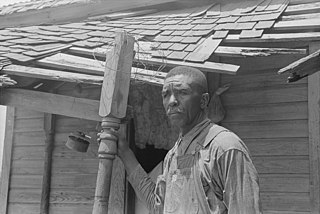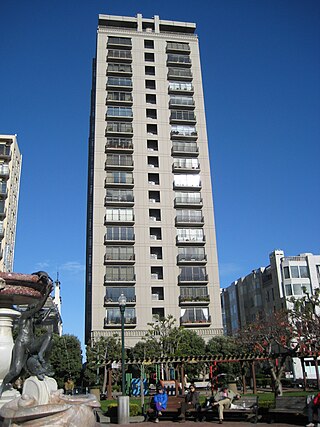
A tenant farmer is a person who resides on land owned by a landlord. Tenant farming is an agricultural production system in which landowners contribute their land and often a measure of operating capital and management, while tenant farmers contribute their labor along with at times varying amounts of capital and management. Depending on the contract, tenants can make payments to the owner either of a fixed portion of the product, in cash or in a combination. The rights the tenant has over the land, the form, and measures of payment vary across systems. In some systems, the tenant could be evicted at whim ; in others, the landowner and tenant sign a contract for a fixed number of years. In most developed countries today, at least some restrictions are placed on the rights of landlords to evict tenants under normal circumstances.
A leasehold estate is an ownership of a temporary right to hold land or property in which a lessee or a tenant has rights of real property by some form of title from a lessor or landlord. Although a tenant does hold rights to real property, a leasehold estate is typically considered personal property.
Replevin or claim and delivery is a legal remedy which enables a person to recover personal property taken wrongfully or unlawfully, and to obtain compensation for resulting losses.

Distraint or distress is "the seizure of someone’s property in order to obtain payment of rent or other money owed", especially in common law countries. Distraint is the act or process "whereby a person, traditionally even without prior court approval, seizes the personal property of another located upon the distrainor's land in satisfaction of a claim, as a pledge for performance of a duty, or in reparation of an injury." Distraint typically involves the seizure of goods (chattels) belonging to the tenant by the landlord to sell the goods for the payment of the rent. In the past, distress was often carried out without court approval. Today, some kind of court action is usually required, the main exception being certain tax authorities – such as HM Revenue and Customs in the United Kingdom and the Internal Revenue Service in the United States – and other agencies that retain the legal power to levy assets without a court order.

Crofting is a form of land tenure and small-scale food production peculiar to the Scottish Highlands, the islands of Scotland, and formerly on the Isle of Man. Within the 19th-century townships, individual crofts were established on the better land, and a large area of poorer-quality hill ground was shared by all the crofters of the township for grazing of their livestock. In the 21st century, crofting is found predominantly in the rural Western and Northern Isles and in the coastal fringes of the western and northern Scottish mainland.

The Crofters Holdings (Scotland) Act 1886 is an Act of the Parliament of the United Kingdom that created legal definitions of crofting parish and crofter, granted security of land tenure to crofters and produced the first Crofters Commission, a land court which ruled on disputes between landlords and crofters. The same court ruled on whether parishes were or were not crofting parishes. In many respects the Act was modelled on the Irish Land Acts of 1870 and 1881. By granting the crofters security of tenure, the Act put an end to the Highland Clearances.
The assured shorthold tenancy (AST) is the default legal category of residential tenancy in England and Wales. It is a form of assured tenancy with limited security of tenure, which was introduced by the Housing Act 1988 and saw an important default provision and a widening of its definition made by the Housing Act 1996. Since 28 February 1997 in respect of accommodation to new tenants who are new to their landlords, the assured shorthold tenancy has become the most common form of arrangement that involves a private residential landlord. The equivalent in Scotland is short assured tenancy.
Helvering v. Bruun, 309 U.S. 461 (1940), was an income tax case before the Supreme Court of the United States. It is notable for holding that under section 22(a) of the Revenue Act of 1932, income need not be in the form of cash for it to be taxable. Gain may occur as a result of exchange of property, payment of the taxpayer's indebtedness, relief from a liability, or other profit realized from the completion of a transaction.

An assured tenancy is a legal category of residential tenancy to an individual in English land law. Statute affords a tenant under an assured tenancy a degree of security of tenure. A tenant under an assured tenancy may not be evicted without a reasonable ground in the Housing Act 1988 and, where periodic changes in rent are potentially subject to a challenge before a rent assessment committee.

The Landlord and Tenant Act 1987 is an Act of the Parliament of the United Kingdom.

The Landlord and Tenant (Covenants) Act 1995 is an Act of the Parliament of the United Kingdom.

The Landlord and Tenant Act 1730 is an Act of the Parliament of Great Britain that regulates certain aspects of the relationship between tenants and their landlords.

The Landlord and Tenant Act 1709 is an Act of the Parliament of Great Britain that regulates the relationship between tenants and their landlords.

The Highland Clearances were the evictions of a significant number of tenants in the Scottish Highlands and Islands, mostly in two phases from 1750 to 1860.

Landlord–tenant law is the field of law that deals with the rights and duties of landlords and tenants.

The Defective Premises Act 1972 is an act of the Parliament of the United Kingdom that covers landlords' and builders' liability for poorly constructed and poorly maintained buildings, along with any injuries that may result. During the 19th century, the common law principle that a landlord could not be liable for letting a poorly maintained house was established, while a long-running principle was that, in practice, builders could not be sued for constructing defective buildings. The courts began to turn against the first principle during the 20th century, imposing several restrictions on the landlord's immunity, but the landlord was still largely free from being sued.
The history of rent control in England and Wales is a part of English land law concerning the development of rent regulation in England and Wales. Controlling the prices that landlords could make their tenants pay formed the main element of rent regulation, and was in place from 1915 until its abolition by the Housing Act 1988.
The Residential Tenancies Act, 2006 is the law in the province of Ontario, Canada, that governs landlord and tenant relations in residential rental accommodations. The Act received royal assent on June 22, 2006, and was proclaimed into law on January 31, 2007. The Act repealed and replaced the Tenant Protection Act, 1997. Ontario's Landlord and Tenant Board (LTB) is governed by the act.
The South African law of lease is an area of the legal system in South Africa which describes the rules applicable to a contract of lease. This is broadly defined as a synallagmatic contract between two parties, the lessor and the lessee, in terms of which one, the lessor, binds himself to give the other, the lessee, the temporary use and enjoyment of a thing, in whole or in part, or of his services or those of another person; the lessee, meanwhile, binds himself to pay a sum of money as compensation, or rent, for that use and enjoyment. The law of lease is often discussed as a counterpart to the law of sale.

The Landlord and Tenant (Ireland) Act 1870 was an act passed by the Parliament of the United Kingdom in 1870.











